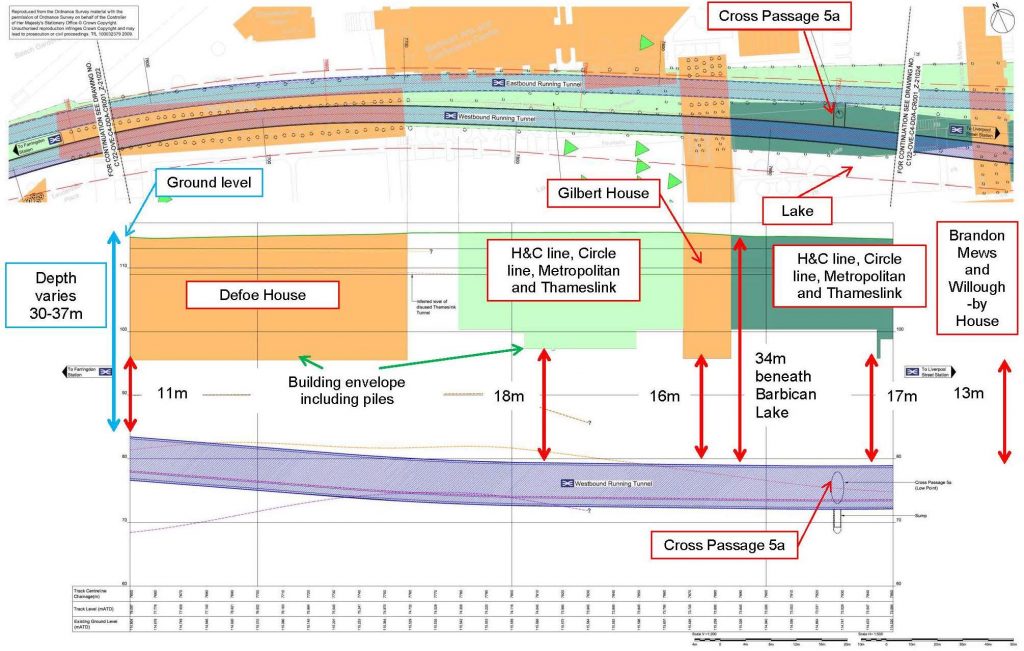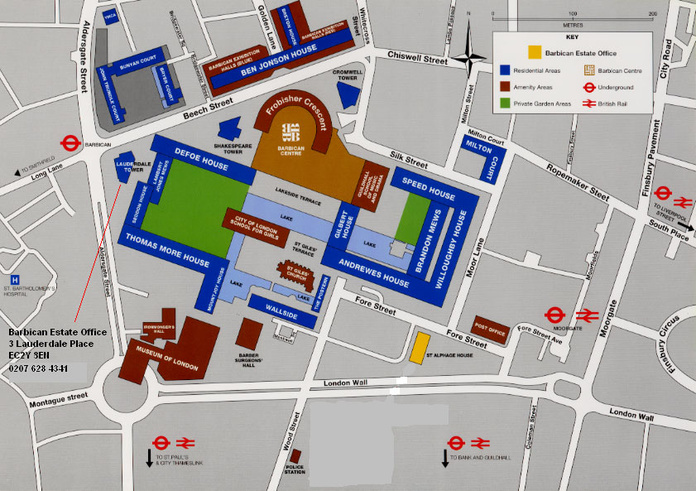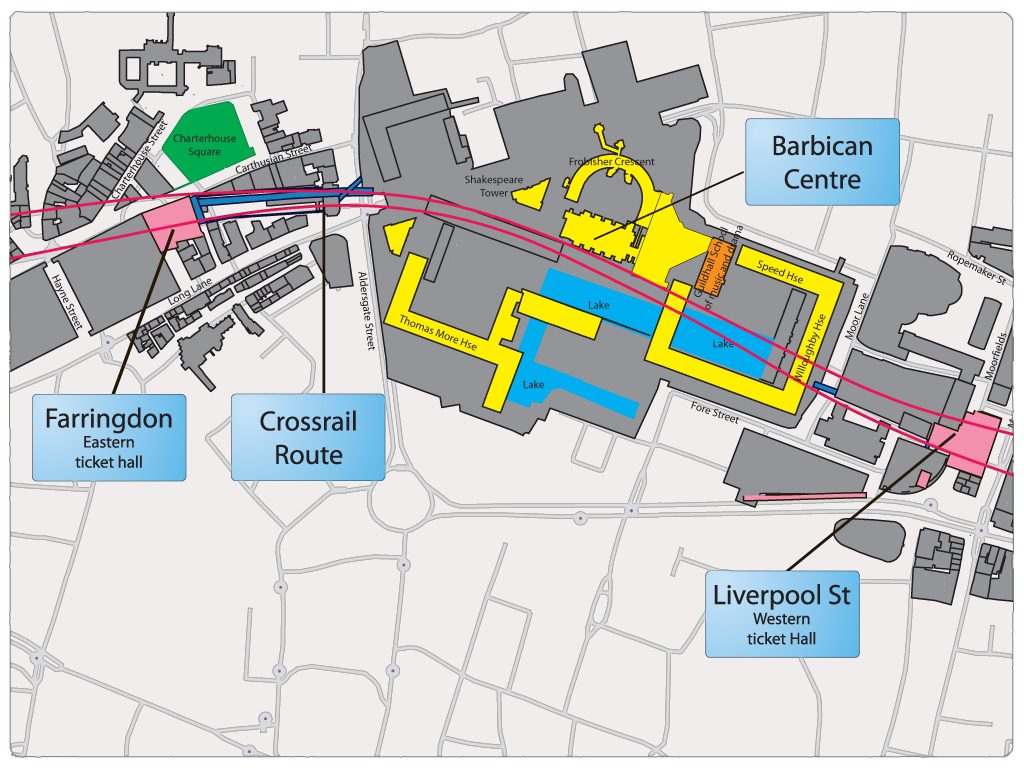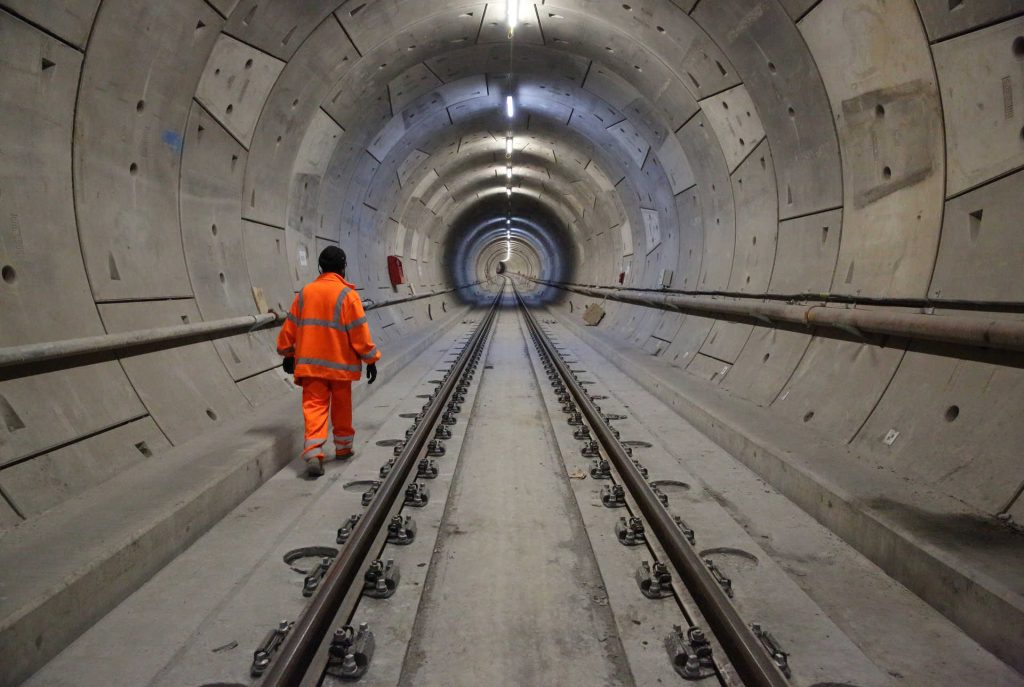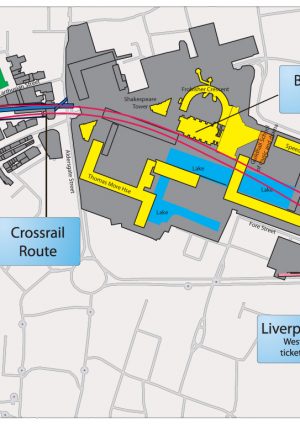
Tunnelling under the Barbican – engaging stakeholders
Document
type: Technical Paper
Author:
Nina Radford MA
Publication
Date: 19/09/2017
-
Abstract
Tunnelling under the Barbican raised significant concerns from both the Barbican Centre and residents. The Barbican Centre required assurances that its concert programme would be undisturbed by both the construction and operational railway. And residents were concerned about settlement and building damage. This case study describes the extensive programme of consultation, engagement and briefing, as well as changes to track design and construction methods, which were undertaken to manage these concerns. It will be of interest to major project organisations engaged in tunnelling projects
-
Read the full document
Introduction and context
The Barbican is a Grade 2 listed estate considered to be landmark of modern ‘Brutalist’ architecture. It was built in over the 1960s and 1970s on a site in the heart of central London that had been bombed in the Second World War. The estate houses the internationally renowned Barbican Arts Centre as well as approximately 4000 residents living in 2014 apartments in 3 tower blocks and 13 terrace blocks, and two schools, all grouped around a central lake. A podium links all the facilities in the Barbican, providing a pedestrian route above street level.
At the time that the Crossrail Bill was proceeding through Parliament, the City of London Corporation, the local authority for the Barbican area as well as the freehold landowner, petitioned on behalf of its residents and the Barbican Arts Centre for parliamentary undertakings which sought to impose limits on construction and operational noise from the railway.
The Hammersmith and City, Metropolitan and Circle lines already run underneath the Barbican Estate at a depth of approximately 18 metres. The proposed Crossrail tunnels in this area run to a depth of 30+ metres so are significantly deeper, however the largest concert hall in the Arts Centre complex, Concert Hall 1, is 2 storeys below ground level, only 17 metres above the Crossrail tunnels.
Figure 1 – Plan and long section of Crossrail tunnels under the Barbican
Figure 2 – Barbican Estate map
The City of London Corporation in its petition raised concerns that acoustic conditions in the Concert Hall could be seriously adversely affected during the construction of the works and the running of the railway. An Agreement was made with the City of London Corporation that required ground-borne noise to be controlled, set requirements for notification of tunnelling progress and specified the type of track to be installed in order to protect the Concert Hall.
The Environmental Minimum Requirements provide for criteria, as set out in Information Paper D10, for ground borne noise arising from the construction railway to not exceed 25 dB LAeq(max, s)in the case of concert halls and theatres. This does not include the passage of the Tunnel Boring Machines (TBMs) for two reasons:
- At a typical progress rate of 100m a week, the duration of the passage of a TBM past any one sensitive receptor is relatively short such that its impact is not considered to be significant;
- There is little that can be practically done to control ground borne noise and vibration from TBMs because of safety and settlement reasons.
Agreed changes to design and method at Bill stage
The changes to design which were made in the light of these concerns included the incorporation of a high performance floating track slab to be installed in the vicinity of the Concert Hall, incorporating a high density concrete slab jacked up on springs in order to isolate noise and vibration.
In terms of changes to method, a particular specification for the temporary construction track was also agreed. Limits were also agreed to the speed of construction trains to travel no more than 5km an hour. The Undertaking also included a speed restriction for operational trains.
For more information see the Noise and Vibration Controls for the temporary construction railway case study.
The remainder of this paper will focus on the information and consultation prior to the passage of the Tunnel Boring Machines (TBMs) under the Barbican.
Crossrail communication objectives
Crossrail Ltd has a dedicated community relations team that sits within its External Affairs Directorate. This comprises a 24-hour Helpdesk which is the first point of contact for complaints, and a team of area-based Community Relations Managers and Officers. The community relations team oversees the work of the ‘front line’ community relations staff in the Tier 1 contractors and acts as a point of escalation for complaints. The team proactively plans communication strategies for key stakeholder groups, particularly where more than one contractor has a significant interface with them. The Barbican residents are one such group as they are affected by construction works for two ticket halls (Farringdon East, and Moorgate) as well as the tunnelling.
Crossrail’s community relations objective can be summed up as ‘No surprises’ – the team aims to give the right information to the right people at the right time, to be open and honest, and to manage expectations effectively, allowing the construction team to get on and build the railway.
Crossrail holds regular Community Liaison panels for key work sites along the route, to serve as a two-way channel between the Crossrail project and the local community on aspects of the Crossrail scheme which may affect the community and environment in the area.
A number of communication channels were used in the Barbican area:
- 6 monthly Community Forum
- Formal notices
- Information sheets about works
- Special meetings about tunnelling
- Crossrail website including Near You page with information about works
These are covered in detail below.
Crossrail City of London Residents’ Forum
The community liaison panel was established in February 2010 and meets every 6 months. The meetings are chaired by an elected Member of the City of London Corporation and the attendees are mainly composed of Barbican residents, whose representation is organised by the Barbican Association, the recognised independent residents association for the estate.
The Barbican Association elects representatives for each block and these were invited to attend the Crossrail Forum, although it was usually residents from the blocks nearest the station ticket hall worksites at the far east and west of the estate who actually attended. Usually the number of attendees was fairly limited, on average 15 attendees external to the project. The Forum meetings received works updates on the progress of construction of the two Crossrail station ticket halls nearest the Barbican as well as presentations on other topics of interest such as the tunnelling progress, and Urban Realm reinstatement designs.
Learning point: Notwithstanding the established Community Forum structure, it was recognised that a wider group of residents than those who were interested in the construction of the ticket halls had a concern about the potential impact of ground movement or settlement on their properties, as it was well known that the route travelled underneath the Barbican. Larger meetings focusing on tunnelling and settlement attracted over 20 times the number of residents than the ordinary forum meetings.
Figure 3 – Plan of tunnel route in Barbican area
Formal notices to residents
Because of the fact that the majority of residential blocks sat within the 1mm settlement contour or within the limits of land to be acquired or used, most properties had received:
- Notification of the scheme during public consultation in 2003 and 2004 with invitations to information events held at Ironmonger’s Hall
- A Parliamentary Notice at the time of the Crossrail Hybrid Bill in 2005 (for those within limits of land to be acquired or used)
- A notice advising property owners of their right to a settlement deed in 2010
- Letters arranging a pre-condition survey of properties 3 months in advance of tunnelling in 2014
- Notices about the installation of monitoring equipment in 2014
- Information sheet two weeks in advance of Tunnel Boring Machine Transit in 2015
- An Information sheet post-tunnelling in 2015
- A notice regarding the removal of monitoring in 2016
- Notices about post construction condition surveys in 2016-7.
Learning point: Although Crossrail distributed notices to all affected properties, there were a high number of sub-let properties where the occupier was not the owner. There were difficulties gaining access to the properties to carry out pre- and post- tunnelling building surveys in the rented properties. In the end the Community relations team worked with the City of London Barbican Estates office to ensure that the owners were separately contacted. However for some properties after repeated attempts, only external surveys could be carried out.
Learning point: the (necessarily) legal tone of some of the notices was not always consistent with a plain English approach. This necessarily triggered the preparation of a parallel community relations strategy to ensure that the Barbican Association had a clear explanation of what the notices meant in practice.
Concerns raised by residents
Once residents understood the depth of the tunnels and were less concerned about noise and vibration, the key remaining concern about the tunnelling works was damage arising from settlement during tunnelling. As well as cracking to properties, residents cited operational concerns about sticking doors and windows, and the risk of lifts malfunctioning in tower blocks. There was also some confusion about the role of settlement deeds.
Settlement Deeds are a legal undertaking that owners of a property could request from Crossrail. These give certain additional rights beyond Crossrail’s obligations as set out in Information Paper D12-Ground Settlement . For example, deed holders automatically receive a copy of the settlement assessment without having to request it. However owners don’t need to have a Settlement Deed to benefit from the settlement policy and associated protection measures. The deadline to apply for a deed was no later than 10 months before the works were scheduled to take place.
In Spring 2011, Crossrail reported to the regular City Residents forum meeting that the settlement assessments for the Barbican were almost complete. This generated some questions about the purpose of settlement deeds and who should obtain one. Following this meeting it was agreed with the Barbican Association that Crossrail would give a follow up presentation to them, explaining the settlement assessment process in some detail, along with the role and function of settlement deeds. This took place as the assessments completed, and no significant damage was predicted for the Barbican, which had received a higher level of scrutiny due to its listed status. The presentation was given by Mike Black, the Crossrail Head of Geotechnics, who also explained how buildings would be monitored. The Barbican Association posted a summary note of the presentation on the Barbican’s own website, and the technical reports on settlement assessment produced by Crossrail were available for review by Barbican residents in the Estate Office.
In 2013, the Chair of the Barbican Association, Jane Smith, reported that residents were aware the deadline for the issue of Settlement Deeds was looming (the deadline was 10 months prior to construction, as estimated at that time) and she had received many requests for further information from concerned residents about settlement deeds and tunnelling. Crossrail agreed with the Barbican Association that it would be a good idea to host a wider open meeting for all interested residents and that the Barbican Association would assist in advertising this. The Chair of the Barbican Association drafted a short summary note covering the settlement presentations to date, which she passed to Crossrail Community relations to fact-check and verify with the geotechnical team before it was issued on the residents’ own Intranet.
Learning: Using this method of disseminating the information more widely using the residents’ own spokesperson and online message board was beneficial in ensuring that the information was trusted. Throughout the engagement with the Barbican, the Chair played a very valuable role both in advising the project when it should provide more information and in helping the Crossrail community relations team to pass that information onto others. Building a good relationship with the Chair via the Community forum and the Barbican Association over a number of years was important to establish the trust necessary for this process.
However the communications resulted in a great deal of requests for Settlement deeds, with 108 being given across the estate. Even though we were as clear as possible that a deed was not necessary to benefit from Crossrail’s building protection policies.
Tunnelling presentations
The first open presentation took place on 24 September 2013 and was hosted at the City of London School for Girls main school hall, and it is estimated that as the hall was full, over 200 people attended. An exact figure is not available as we did not require attendees to register, as we wanted to promote as wide an attendance as possible.
In advance of the meeting, the Crossrail community relations manager met with the Chair of the Barbican Association to agree the agenda for the meeting and key topics that the presentation ought to cover to satisfy the concerns of residents. Having these topics in advance allowed Crossrail community relations to put together a Frequently Asked Questions document which was made available at the meeting and circulated afterwards by the Barbican Association.
The presentation included, as well as tunnelling activity to date, and a programme of works going forward under the Barbican:
- Mitigation measures for noise and vibration
- Settlement assessment results for the Barbican Estate (reminder of previous presentations)
- Actual settlement (Volume loss) to date on tunnelling on other areas of the project
- Settlement deeds, entitlements & deadline
- Mitigation of settlement
- Installation of monitoring equipment
- Defect surveys – access requirements
- Procedure for repairs post tunnelling
- Ongoing communications
Helpfully, the TBM tunnelling under the West End was complete at the time of the presentation, so actual data could be presented that demonstrated in almost all cases the actual settlement was lower than predicted.
The project decided to use two speakers who were already familiar to some residents who had attended the City of London Residents forum, even though one (Bill Tucker) had been promoted to the more senior position of Central Area Director. Mike Black, the Head of Geotechnics, was the other key speaker, who had already built a degree of trust with the Barbican Association at the earlier meetings on settlement. Other technical experts were on hand in the audience to answer specific questions (e.g. on noise.) Time was taken to explain fairly complex topics, on the basis that it was clear from previous meetings with Barbican residents that the audience were interested in detailed aspects of the proposals, and the follow up Q & A did focus on in-depth questions about settlement monitoring and management.
Learning: Using senior level specialist and delivery staff instead of communications specialists generated very positive feedback (for example this blog from a local resident) that we had brought ‘the real people’ i.e. people with actual responsibility for the project and who were very knowledgeable about what they were delivering.
In June 2014 a further open invitation residents’ meeting was held on the subject of building defect surveys, a couple of months prior to the surveys taking place. The purpose was to tell residents what to expect, how they would be contacted, and to introduce the contractor who would be undertaking the surveys, and the format of the survey report that would be produced.
In January 2015 a third open event was held at the City of London School for Girls, a few months prior to the passage of the TBMs. Approximately 150 people attended this event. For continuity the same speakers attended with only one additional speaker, the director responsible for the tunnelling. The key topics of this second meeting were:
- Update on programme: the section of tunnelling under the Barbican was one of the last to be completed, so at the time of the presentation 6 out of 8 tunnel drives were complete.
- Reminder on noise mitigation measures including the Floating Track slab
- Reminder on who to contact – as well as the 24 hour helpline number – the actual contractor’s community relations staff responsible for handling complaints in ‘real time’ from the contractor were introduced
- Procedure for reporting defects, insurance claims and repairs
- Update on the programme of fit-out works post tunnelling
Although much of the same ground was covered as in 2013, it was important to repeat these messages given the potential for turnover particularly for rental occupants of the flats. In the Q & A residents were very interested in the design and geographical extent of the mitigation measures such as the floating track slab, and it was important to ensure once again that specialists were on hand to answer these. There were more questions on noise, given that some complaints had been received about the breakout of a temporary tunnel headwall at Moorgate at the end of 2014. The breaking out of headwalls out of and into the station boxes was the only generator of noise complaints in relation to the deep level tunnels. Understandably though this generated some concern and required some careful explanation as it was perceived as being the ‘beginning’ of the tunnelling under the Barbican.
Open days and tours
Throughout the project Crossrail and its contractors have hosted open days at the Moorgate and Farringdon station sites specifically for Barbican residents, usually on an annual basis. The tunnelling contractor also took the Chair of the Barbican Association on a tour of the tunnel boring machine as it commenced its journey under the Barbican.
These site visits have helped to build positive relations with residents, who gain a much greater understanding of the scale of construction, site constraints and logistical challenges by seeing them first-hand.
Communications with Barbican Arts Centre
The City of London asked the project to provide three years’ advance notice of the timing of the passage of the TBMs running underneath the Barbican to the Arts Centre. These requests were made due to concerns about disruption to the Concert hall performances. It is understood that the requirement for significant advance notice was so that the concert hall could aim to manage its advance bookings to ensure that major public performances, particularly international artists, and live performances that would be recorded, would not coincide with the passage of the TBMs.
Following the advance notice, there was a requirement for regular updates to the City of London and the Barbican Arts Centre, more frequently during the final year prior to TBM transit which took place in Spring 2015.
As the TBMs transited through other parts of London, and the date of transit under the Barbican grew closer, it became clear that it would not be possible to accurately predict exactly when they would arrive. As well as factors with the tunnelling itself (necessary stoppages to maintain/ repair the TBMs) the co-ordination with temporary works in station worksites to allow transit resulted in programme changes.
More positively, experience was showing that there were negligible noise complaints (ultimately only 3 noise complaints were received in relation to TBM passage on the whole of Crossrail) and the project was convinced that there was unlikely to be any audible noise in the Barbican.
In the light of this, it became necessary for the Crossrail environmental and community relations teams to broker a direct conversation between the tunnelling contractor and the Barbican Arts Centre to try to satisfy their concerns about noise. Three meetings took place involving the Operational Director of the Arts Centre and the Crossrail Project Manager for the tunnelling, as well as Crossrail’s noise specialist and the Community Relations Managers for both Crossrail and the lead Contractor, at the time that the contractor was applying for prior consent under Section 61 of the Control of Pollution Act 1974 to minimise construction noise from the worksites.
Once it had been explained that the concert schedule could not be programmed around the TBMs, or vice versa, the Arts Centre and the City of London Environmental team remained concerned about noise. They sought a documented assurance in the Noise Mitigation Plan submitted by the contractor to the local authority as part of the environmental consent process that, if noise was an issue, the TBMs would be stopped. The project was reluctant to agree to this as there was a desire to minimise any ground settlement related to unplanned stoppages. The following statement was agreed:
In the event that the monitoring identifies that construction trains might cause interference during such times, we will consider all reasonable and practical mitigation measures, to avoid or minimise running of construction trains in the impacted period.
In the event of a complaint during a sensitive performance, an investigation would be carried out in ‘real time’. In the event that the complaint is validated the Duty Manager will consider reasonable and practical mitigation measures and these will be communicated back to the Barbican Centre.
In the meetings, proposals were agreed for both proactive and reactive noise monitoring. Proactive baseline noise monitoring was carried out in the tunnels and in the Concert Hall as the TBM was approaching the Arts Centre and passed to the City of London in advance of the transit date, and this showed no or negligible impact on the baseline. It also helped that the Community Relations Manager for the contractor was able to meet and reassure the Arts Centre staff in person that it was he that would be answering their phone call.
At the time the TBM was transiting under the Barbican at a depth of 40 metres:
- The London Symphony Orchestra played concerts above
- The City of London residents meeting took place at the City of London School for Girls (attendees couldn’t hear any noise from tunnelling)
- The Arts Centre Operations Director’s concerns were satisfied to the point he was happy to be on holiday during the TBM passage
- No noise from the TBMs or the operation of the construction railway under the Barbican estate was discernible and no noise complaints were received.
Subsequently:
There have been, from 2,014 flats, a total of 49 insurance claims for damage to flats, all of which were for minor cosmetic internal cracking in line with the settlement assessment (hairline cracks, or fine cracks easily treated with normal redecorations), a proportion of which were upheld by Crossrail’s insurers.
Table 1 – Settlement damage categories from Information Paper D12
Risk Category
Description of typical damage and likely form of repair for typical masonry building. 0
Negligible
Hairline cracks. 1
Very Slight
Fine cracks easily treated during normal redecorations. Perhaps isolated slight fracture in building. Cracks in exterior brickwork visible upon close inspection. 2
Slight
Cracks easily filled. Redecoration probably required. Several slight fractures inside building. Exterior cracks visible; some repointing may be required for weathertightness. Doors and windows may stick slightly. 3
Moderate
Cracks may require cutting out and patching. Recurrent cracks can be masked by suitable linings. Tuck‑pointing and possibly replacement of a small amount of exterior brickwork may be required. Doors and windows sticking. Utility services may be interrupted. Weathertightness often impaired. 4
Severe
Extensive repair involving removal and replacement of sections of walls, especially over doors and windows required. Windows and door frames distorted. Floor slopes noticeably. Walls lean or bulge noticeably, some loss of bearing in beams. Utility services disrupted.
Learning point: We could have been clearer in the presentations to residents about the time it would take to settle insurance claims, as this has been the main complaint from the tunnelling. Unless damage needed urgent repair (e.g. fixing a sticking door) claims were held until such time as works and ground settlement related to tunnelling was complete.
In practice Crossrail needed to reach agreement with The City of London (freeholder and local authority) that settlement attributable to the project was indeed complete before claims could be settled. There was also a preference from the City of London for a post construction survey to take place in all affected properties. As a result most claims were not settled until 18 months after the passage of the TBMs.
Conclusion
There have been no problems to date during the construction of the tunnels and the floating track slab in meeting the construction noise limits, and no noise complaints arising from the deep level tunnelling works in this area.
Figure 4 – Track installed on floating track slab in Barbican area
However there were concerns from residents about settlement which needed to be addressed. Large scale events rather than written communication seemed to work well for a large residential estate in explaining the settlement assessment, monitoring and mitigation processes.
There can be no doubt that having an engaged and well organised residents association was a key factor in ensuring the success of these events. Listening to the stakeholder, in this case the Chair of the Barbican Association, and responding to the issues raised worked well. The Chair helped to pinpoint areas of concern in advance allowing Crossrail staff to plan and address these in the presentation material. The Association also helped to feed information directly back to its members, usefully supplementing the information being distributed by the project.
With hindsight much of the concern arose not immediately before the tunnelling but upon receipt of the formal notices about settlement deeds and monitoring installation. Future projects should give consideration to planning communication events at the time that these notices are issued, even if it seems premature in relation to the works themselves.
It is also recommended that future projects, particularly in cities, acknowledge the impact of the buy-to-let phenomenon and the difficulties this brings in contacting building owners for legal notices and access requests. Land referencing owners and working with building managers to contact owners is likely to be more effective than simply writing to occupiers.
-
Authors
Nina Radford MA - Crossrail Ltd
Nina Radford has a Masters in Planning and 17 years’ experience working on major transport and urban regeneration projects in London and Melbourne.
Nina was a Community Relations Manager at Crossrail from September 2010 to March 2017, responsible for managing the project’s stakeholder relations in the City of London area.
